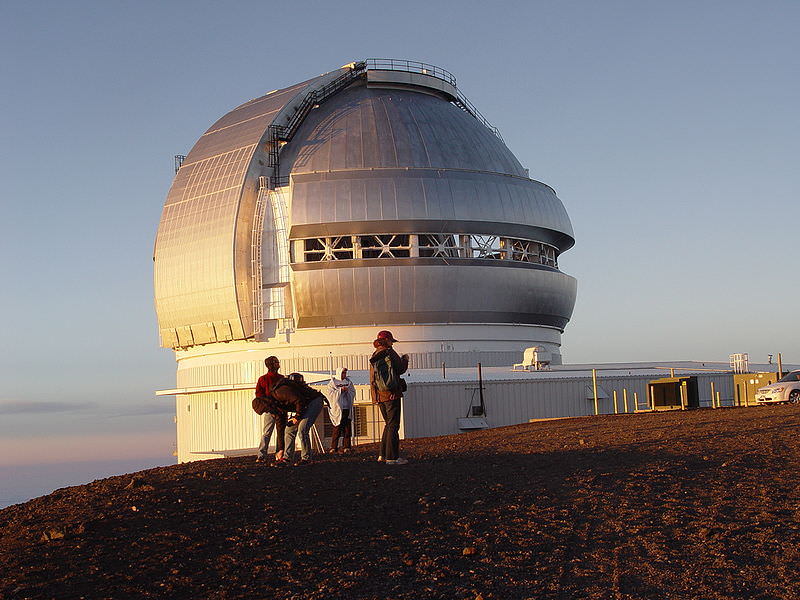The Gemini Multi-Object Spectroraph on the Fredrick C. Gillett Gemini North Telescope on Mauna Kea in Hawaii captured this beautiful image of the ring galaxy NGC 660. The galaxy lies about 40 million light-years from Earth toward the constellation Pisces the Fishes. The field of view of the zoomed out image is 9.3×5.6 arcminutes. North is to the right and east is up. Total exposure for the image for all filters was 1,620 seconds. Credit: Gemini Observatory/AURA.
Strings of gas and dust, the wreckage of a colossal galactic struggle, lie strewn and littered about polar-ring galaxy NGC 660 in this new image from the Gemini Observatory.
Zoom around the ring of stars, stop to dive into massive star clusters and pink nebulae rich with the birth of new stars. Astronomers have found only a few of these bizarre objects. Most are made up of an early-type spiral galaxy, known as a lenticular galaxy, surrounded by a vast ring of stars extending for tens of thousands of light-years nearly perpendicular to the plane of the main galaxy. NGC 660, however, is the only polar-ring galaxy with a late-type lenticular galaxy as host.
Fancy a new background image? Click here to engalactinate and create a new desktop for yourself.
NGC 660 was captured with the Gemini Multi-Object Spectrograph on the Fredrick C. Gillett Gemini North Telescope atop Hawaii’s Mauna Kea volcano.
How these gossamer rings around their host galaxies form mystifies astronomers. One current model pits one galaxy piercing the heart of another galaxy. The enormous tidal tug of gravity strips stars and gas and scatters them into the huge ring. NGC 660’s ring extends across 40,000 light-years.
As a bonus to the awesome display of galactic tug-of-war, pan across the dozens of faraway background galaxies. Another bonus is the story continues with tales of galactic violence and dark matter. Check it out here.
Source: Gemini Observatory


NGC 660 is in Pisces, the position is 01h 43m 02s +13° 38′ 34″. It was discovered by William Herschel in 1784. Its visual magnitude is 11.4v and is visible in 15cm telescopes.
The second link is well worth a read: It’s very interesting—and well written.
Elegance and beauty, splendor and glory—from “train wrecks”, and “bloody aftermath”s? Violence—a destructive tearing-down; not a constructive building-up—causing renewal? Those, and other characterizations are annoying–and, perhaps, misleading.
Do such descriptions do justice—truly represent what is being seen? Do they capture, really define the actual process that creates: “Poetry in Motion”? Where does one find grace in ugly wreckage, or aesthetic rhyme in wake of horrid violence? A form of artful order from passing interaction of galaxies wrought, marvelous change from their joining mergers, accretion formations forged, and the glittering rings of cast splendor—creating colorful new radiance, strewn in pleasing forms through an Island Universe’s celestial night. In moving frames of dust and gas, the orchestrated harmony of colored glass. What is shattered like a fallen lamp, on the pavement broken? Light falling dead? Is it not more like a “rainbow’s glory [being] shed”? (Shelley)
Perhaps I am in the dark, and from its “scientific” reason, blind.
Is there really “death” from struggle and conflict, still suspended, in these heavenly portraits frozen in time? Or rather, or are they visible forms of vigorous transformation, profiled stages of dynamic growth? “Evolution of galaxies”, as would be more commonly stated in line?
A Chaotic “collision” in past space? Or, a graceful choreography of dancing embrace? How many stars were actually shattered in these slow-passing movements of gravity’s waltzing turns? How many are left cold in darkness from its hold? Do galaxies expire—in these warming processes, from flowing passages in time? Or are they reinvigorated with new rhythmic life—reborn in bright motions of heated rhyme?
Encounters of strangers in the night, through movements of regulating metronome, reemerge a symphony minuet, magnificently joined as one whole. From stately courtship spin, settled: a beautiful union by glittering ring!
http://apod.nasa.gov/apod/ap121019.html